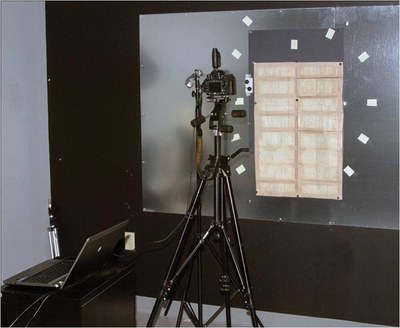
Purchase Tickets
New Technology Reveals Document Secrets

New photographic technology is allowing the Indiana Historical Society to find undiscovered details hidden in historical documents. The process is called reflective transforming imaging – a simple concept with a complicated method.
RTI combines multiple photographs and lighting methods of a single piece to create one blended image conservators can simultaneously view from all lighting angles. The result is a digital view of the piece which cannot be seen by the naked eye.
“It’s a very important tool for conservation,” says David Turk, preservation imaging service manager. “And all you need is a camera, flash and computer.” David learned RTI at a four-day workshop at the Indianapolis Museum of Art sponsored by Cultural Heritage Imaging.
RTI uses three basic steps – capture, processing and viewing – to generate the final file.
First, a photographer takes pictures of the document. Because RTI is such a delicate process, the camera cannot be touched during the shoot. It needs to be in the exactly the same spot for each shot, and even the micro vibrations from shooting can ruin the process. Instead, pictures are taken remotely from a computer. Lighting is placed at 12 different positions, creating a clock-like grid around the document. Light is then angled in four different ways at each position, creating a total of 48 pictures.
Once the photos are taken, the images are loaded into the program. Each image contains a black sphere, usually about the size of a cue ball, which captures the angle of the flash. The software combines the total captured flash points to calculate the light angles and creates the image. Certain functions, such as specular enhancement, create threedimensional views of the document’s surface.
Ramona Duncan-Huse, IHS’s senior director of conservation, says RTI will be an important tool in conserving documents. “The basic premise of conservation is knowing what’s in front of you and all its characteristics before you formulate a treatment,” she says. “I think there’s a lot of technology being developed that conservation can take advantage of, and that’s a real exciting prospect.”
Ramona hopes to use RTI to make IHS collections more available digitally. Susan Rogers, senior conservator, will work with David on the next RTI project, a famous glass plate negative of Abraham Lincoln.
“There are some questions about its handling in the past,” Ramona says. “So we want to examine that a little more deeply for its long-term care.” •








